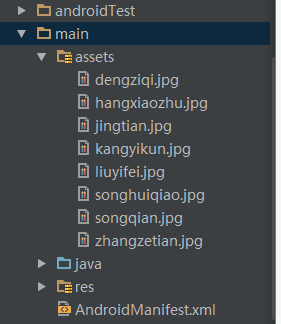-

移动开发
站-
热门城市 全国站>
-
其他省市
-
-

 400-636-0069
400-636-0069
 白羽
2018-06-27
来源 :网络
阅读 1228
评论 0
白羽
2018-06-27
来源 :网络
阅读 1228
评论 0
摘要:本文将带你了解Android开发之如何使用文件初始化sqlite数据库,希望本文对大家学Android有所帮助。
很多时候在应用安装初始化时,需要创建本地数据库,同时为数据库添加数据,之后再从数据库中读取数据。
这里有2个思路
1.先在本地创建一个能支持android使用的sqlite数据库文件,启动时,用现成的sqlite的二进制文件进行直接copy到Android系统的数据库路径
2.可以考虑在第一次启动时,执行数据库初始化的sql文件.
1.在本地准备android能使用的sqlite数据库文件
使用sqlite数据库管理工具,看个人爱好(SQLite Database Browser ,Navicat Premium,)
打开数据库,创建"android_metadata"数据表
Sql代码
1. CREATE TABLE "android_metadata" ("_id" INTEGER PRIMARY KEY AUTOINCREMENT,"locale" TEXT DEFAULT ‘en_US‘);//创建表
2. INSERT INTO "android_metadata" VALUES (1,‘en_US‘);//插入值
创建其他应用需要的表..此处省略.
2.复制文件到应用中.
把第一步创建的数据库文件复制到应用中的assets文件夹, asserts文件夹的路径如下:

然后创建DateBaseHelper extends SQLiteOpenHelper的类文件.
代码如下:
Java代码
1. public class DataBaseHelper extends SQLiteOpenHelper {
2. //The Android‘s default system path of your application database.
3. private static String DB_PATH = "/data/data/YOUR_PACKAGE/databases/";
4. private static String DB_NAME = "myDBName";
5. private SQLiteDatabase myDataBase;
6. private final Context myContext;
7. /**
8. * Constructor
9. * Takes and keeps a reference of the passed context in order to access to the application assets and resources.
10. * @param context
11. */
12. public DataBaseHelper(Context context) {
13. super(context, DB_NAME, null, 1);
14. this.myContext = context;
15. }
16.
17. /**
18. * Creates a empty database on the system and rewrites it with your own database.
19. * */
20. public void createDataBase()throws IOException {
21. boolean dbExist = checkDataBase();
22. if (dbExist) {
23. //do nothing - database already exist
24. } else {
25. //By calling this method and empty database will be created into the default system path
26. //of your application so we are gonna be able to overwrite that database with our database.
27. this.getReadableDatabase();
28. try {
29. copyDataBase();
30. } catch (IOException e) {
31. throw new Error("Error copying database");
32. }
33. }
34. }
35.
36. /**
37. * Check if the database already exist to avoid re-copying the file each time you open the application.
38. * @return true if it exists, false if it doesn‘t
39. */
40. private boolean checkDataBase() {
41. SQLiteDatabase checkDB = null;
42. try {
43. String myPath = DB_PATH + DB_NAME;
44. checkDB = SQLiteDatabase.openDatabase(myPath, null, SQLiteDatabase.OPEN_READONLY);
45. } catch (SQLiteException e) {
46. //database does‘t exist yet.
47. }
48.
49. if (checkDB != null) {
50. checkDB.close();
51. }
52. return checkDB != null ? true : false;
53. }
54.
55. /**
56. * Copies your database from your local assets-folder to the just created empty database in the
57. * system folder, from where it can be accessed and handled.
58. * This is done by transfering bytestream.
59. * */
60. private void copyDataBase()throws IOException {
61. //Open your local db as the input stream
62. InputStream myInput = myContext.getAssets().open(DB_NAME);
63. // Path to the just created empty db
64. String outFileName = DB_PATH + DB_NAME;
65. //Open the empty db as the output stream
66. OutputStream myOutput = new FileOutputStream(outFileName);
67. //transfer bytes from the inputfile to the outputfile
68. byte[]buffer = new byte[1024];
69. int length;
70. while ((length = myInput.read(buffer)) > 0) {
71. myOutput.write(buffer, 0, length);
72. }
73.
74. //Close the streams
75. myOutput.flush();
76. myOutput.close();
77. myInput.close();
78. }
79.
80. public void openDataBase()throws SQLException {
81. //Open the database
82. String myPath = DB_PATH + DB_NAME;
83. myDataBase = SQLiteDatabase.openDatabase(myPath, null, SQLiteDatabase.OPEN_READONLY);
84. }
85.
86. @Override
87. public synchronized void close() {
88. if (myDataBase != null)
89. myDataBase.close();
90. super.close();
91. }
92.
93. @Override
94. public void onCreate(SQLiteDatabase db) {}
95.
96. @Override
97. public void onUpgrade(SQLiteDatabase db, int oldVersion, int newVersion) {}
98. // Add your public helper methods to access and get content from the database.
99. // You could return cursors by doing "return myDataBase.query(....)" so it‘d be easy
100. // to you to create adapters for your views.
101. }
3.现在我们可以创建DateBaseHelper的实现操作了.
createDataBase() //创建
openDataBase()//打开只读数据库
记得要更改"YOUR_PACKAGE"为你的应用的包名
如:com.examplename.myapp
大概代码如下:
Java代码
1. ...
2. DataBaseHelper myDbHelper = new DataBaseHelper();
3. myDbHelper = new DataBaseHelper(this);
4. try {
5. myDbHelper.createDataBase();
6. } catch (IOException ioe) {
7. throw new Error("Unable to create database");
8. }
9. try {
10. myDbHelper.openDataBase();
11. } catch (SQLException sqle) {
12. throw sqle;
13. }
14. ...
本文由职坐标整理并发布,希望对同学们有所帮助。了解更多详情请关注职坐标移动开发之Android频道!
 喜欢 | 0
喜欢 | 0
 不喜欢 | 0
不喜欢 | 0
您输入的评论内容中包含违禁敏感词
我知道了

请输入正确的手机号码
请输入正确的验证码
您今天的短信下发次数太多了,明天再试试吧!
我们会在第一时间安排职业规划师联系您!
您也可以联系我们的职业规划师咨询:

版权所有 职坐标-一站式IT培训就业服务领导者 沪ICP备13042190号-4
上海海同信息科技有限公司 Copyright ©2015 www.zhizuobiao.com,All Rights Reserved.
 沪公网安备 31011502005948号
沪公网安备 31011502005948号